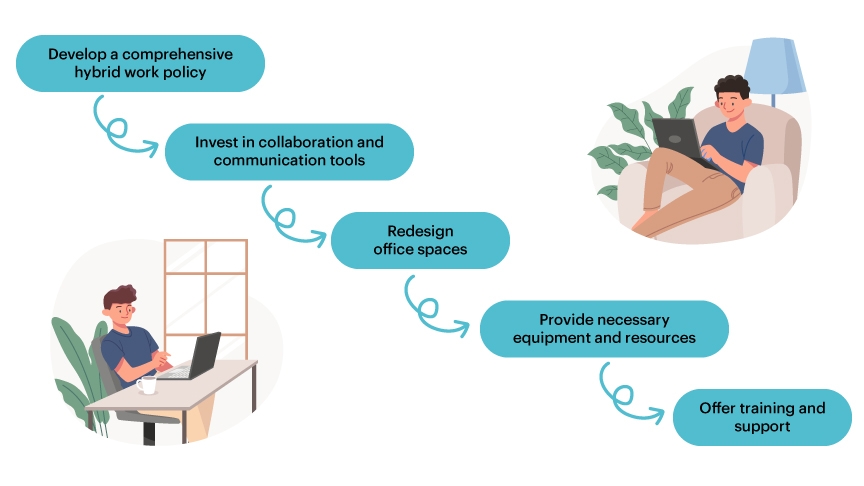The workplace landscape has undergone a seismic shift in recent years. The COVID-19 pandemic accelerated the adoption of remote work, challenging traditional office-centric models. As organizations navigate this new reality, hybrid work models have emerged as a sustainable solution. These models seamlessly integrate physical and virtual workspaces, offering employees flexibility while maintaining collaboration and productivity.
In this article, let’s look at various approaches of hybrid work models already in place and strategies to embrace each of them effectively.
"Explore different types of hybrid work models and how they affect productivity, real estate costs, and team morale. This article offers a deep dive into fixed, flexible, and dynamic hybrid models - helping you find the best fit for your business."
Hybrid Work Models: An Overview
A hybrid work model is a flexible approach that allows employees to work from various locations, including home, the office, or a combination of both. This model aims to strike a balance between the advantages of remote work, such as improved work-life balance and reduced commute times, and the benefits of in-person collaboration, such as fostering team cohesion and maintaining company culture.
The benefits of hybrid work models are numerous. For employees, it offers increased autonomy, flexibility, and work-life balance. They can avoid lengthy commutes, which not only saves time but also reduces stress and environmental impact. Remote work options can also improve productivity by minimizing distractions and enabling focused work in a comfortable environment.
For organizations, hybrid work models can lead to cost savings on real estate and overhead expenses. Additionally, they can tap into a broader talent pool by removing geographical barriers, attracting and retaining top talent from diverse locations. Studies have also shown that hybrid work can boost employee satisfaction, engagement, and overall well-being, leading to higher productivity and reduced turnover.
However, implementing hybrid work models is not without challenges. One of the primary concerns is maintaining effective collaboration and communication among distributed teams. Without proper tools and protocols, remote employees may feel disconnected or experience difficulties coordinating with their on-site counterparts.
Ensuring data security and compliance is another critical challenge. With employees accessing sensitive information from various locations, organizations must implement robust cybersecurity measures and train employees on best practices for safeguarding data.
Managing a workforce split between remote and on-site employees can also pose challenges in terms of equity, fairness, and inclusivity. Organizations must ensure that remote employees do not feel left out or disadvantaged in terms of opportunities, recognition, or career advancement.
Different Hybrid Work Models
Hybrid work models can take various forms, each tailored to an organization's unique needs and culture. This section explores some common models and their characteristics.
1. Office-Centric
In this model, the primary workplace is the office, but employees have the flexibility to work remotely on designated days or as needed. This approach is suitable for organizations that value in-person collaboration and want to maintain a strong office culture while offering some remote work options.
2. Remote-First
As the name suggests, this model prioritizes remote work as the default arrangement. Employees primarily work from home or other remote locations, with occasional in-office gatherings or team meetings. This remote first model is ideal for organizations with a distributed workforce or those that prioritize employee flexibility and autonomy.
3. Flexible Hybrid
This model offers employees the freedom to choose their work location, balancing remote and in-office work as they see fit. Employees can decide whether to work from home, the office, or a combination of both based on their preferences, project requirements, or personal circumstances. This approach promotes a high level of flexibility and tailors the work arrangement to individual needs.
4. Split Operations
In this model, some teams or departments work primarily on-site, while others operate remotely, depending on their job functions or business requirements. For example, roles that require frequent in-person collaboration or access to specialized equipment may be based in the office, while teams with more individual or digital-based work can operate remotely.
Best Practices for Successful Hybrid Work Implementation
Implementing a successful hybrid work model requires careful planning, clear communication, and a holistic approach. This section outlines best practices to ensure a smooth transition and effective execution of hybrid work arrangements.
1. Develop a comprehensive hybrid work policy
A well-defined policy is crucial for setting clear expectations and guidelines for hybrid work. This policy should address issues such as eligibility criteria, communication protocols, performance management, cybersecurity measures, and guidelines for remote and on-site work. Involving employees in the policy development process can foster buy-in and ensure that their needs and concerns are addressed.
2. Invest in collaboration and communication tools
Effective communication and collaboration are essential for hybrid work success. Organizations should invest in robust tools and platforms that facilitate seamless virtual meetings, document sharing, project management, and real-time communication.
Tools like video conferencing software, messaging apps, and cloud-based collaboration suites can help bridge the gap between remote and on-site employees.
3. Redesign office spaces
To accommodate hybrid work, physical workspaces may need to be redesigned or reconfigured. This could involve introducing flexible workstations, collaboration zones, and quiet areas for focused work.
Open office layouts may need to be rethought to provide more privacy and reduce distractions. Additionally, organizations should consider implementing hoteling systems or desk reservation systems to manage the dynamic use of office space.
4. Provide necessary equipment and resources
Ensuring that employees have the right tools and resources is crucial for productivity and efficiency in a hybrid work environment. This may include providing laptops, monitors, ergonomic furniture, and reliable internet connectivity for remote work. Organizations should also consider reimbursement policies for home office expenses or offer stipends for setting up suitable workspaces.
5. Offer training and support
Transitioning to a hybrid work model can be challenging for both employees and managers. Organizations should provide comprehensive training and support to help teams navigate the nuances of virtual collaboration, time management, and leadership in a distributed workforce. This could include workshops, coaching sessions, or online resources focused on developing hybrid work skills.
Summing Up
Hybrid work models represent a paradigm shift in how we approach work and workplaces. Upon effectively integrating physical and virtual workspaces, organizations can unlock numerous benefits, including improved employee satisfaction, increased productivity, and cost savings.
The key to thriving in the hybrid work era lies in embracing flexibility, fostering a culture of trust and accountability, and prioritizing employee well-being. By doing so, organizations can create a harmonious blend of in-person collaboration and remote efficiency, positioning themselves for success in an ever-evolving business landscape.



